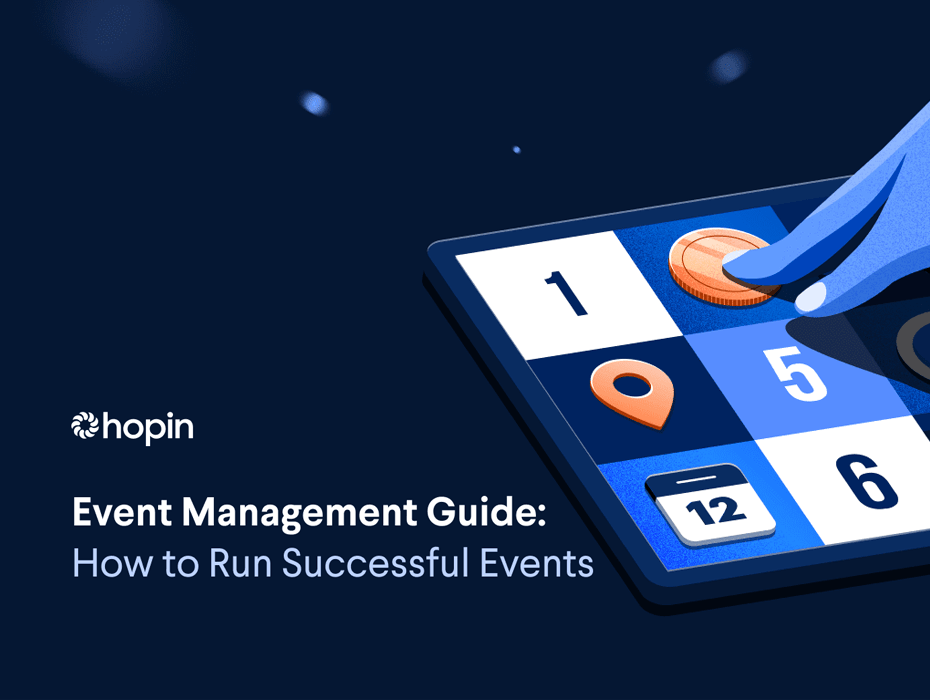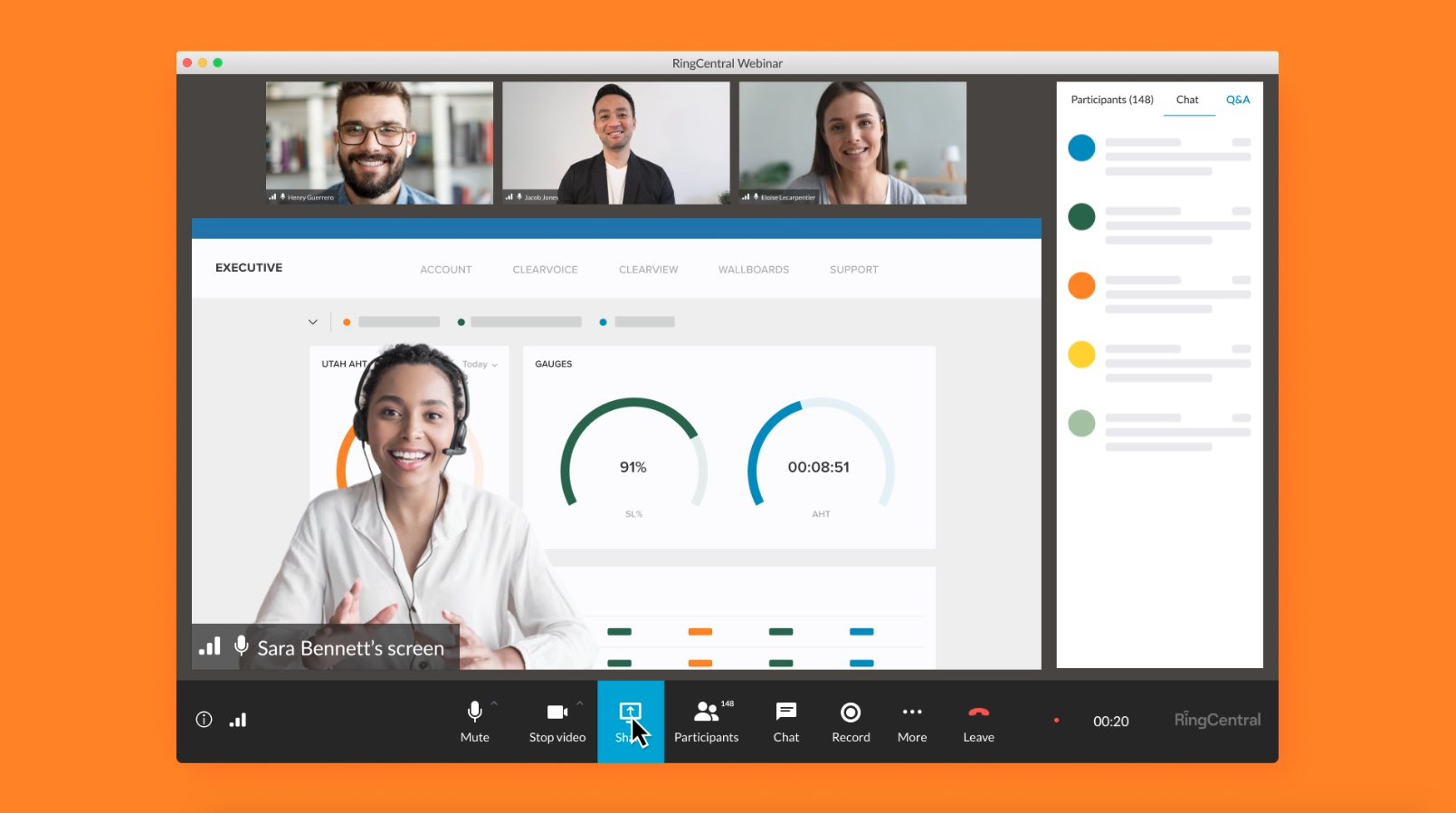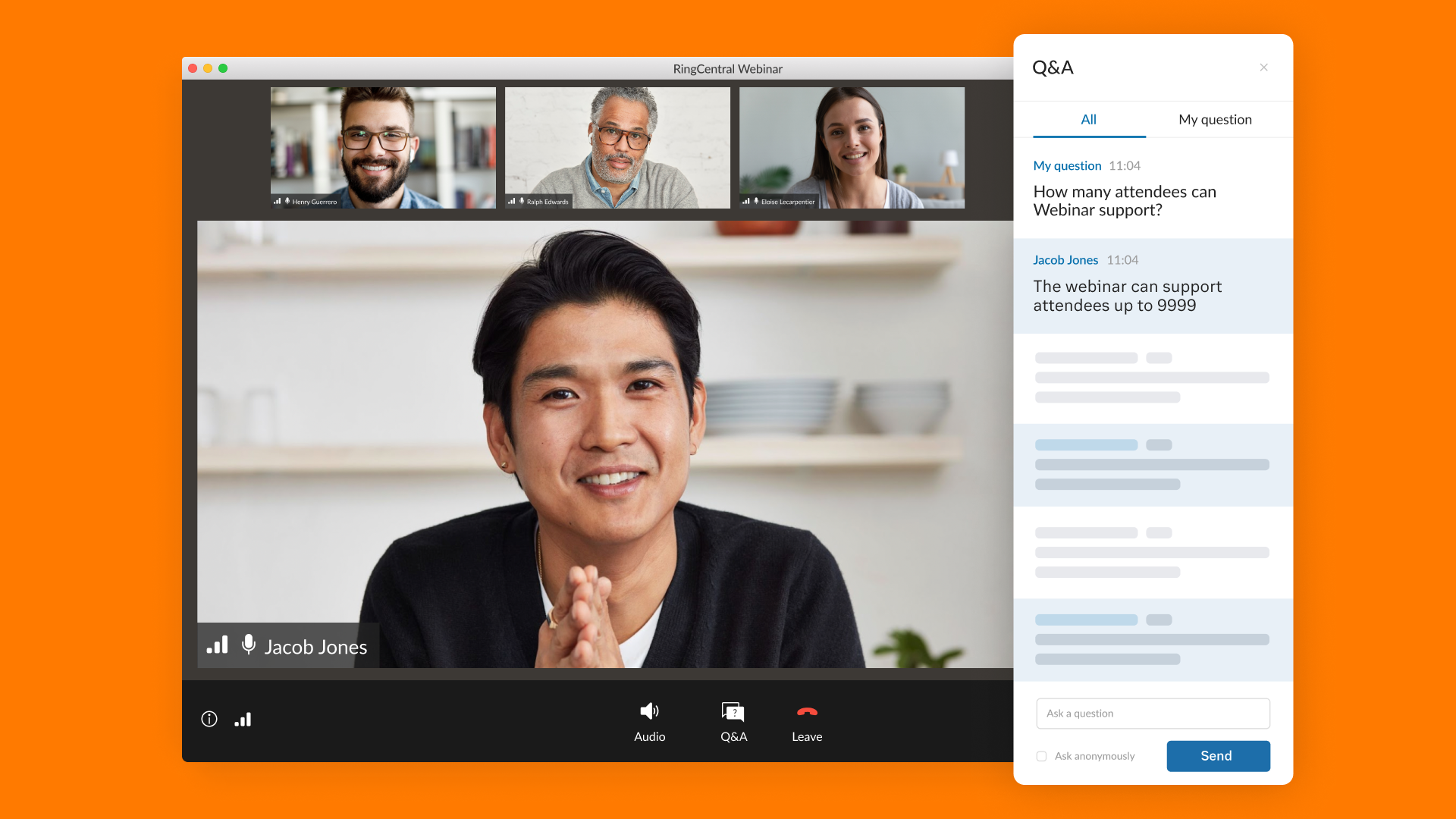From conferences to concerts and ceremonies to celebrations, event management is what allows people to gather and enjoy shared experiences. Paris Fashion Week, Comic-Con, and your company all-hands are all made possible through high-quality event management.
Event management is the act of supervising all the logistics, plans, and moving pieces required to put on a successful gathering –– whether that gathering is in person, virtual, or hybrid. It’s a combination of project management and change management.
In other words, event managers have a lot of responsibilities. Let’s dive into the details so you can get a clear picture.
Event management versus event planning
While these two terms — event management and event planning — are sometimes used interchangeably, they’re distinct functions that come with different responsibilities.
- Event planning focuses on the overall vision and creative direction of an event.
- Event management is the coordination of resources needed to execute that vision.
That said, the confusion between the two functions is understandable. Events have a lot of moving parts and, as a result, event professionals are known to wear many hats — especially when attempting to bring disparate visions together to create a cohesive experience. So, it’s common for event managers to plan events and event planners to manage them.
4 core components of effective event management
A successful event might feel –– to attendees –– like a COVERGIRL commercial: easy, breezy, and beautiful.
But events that go well are the result of a long list of skillfully managed components. Event management features four core categories:
1. Event strategy
This is the stage of event management that overlaps the most with the event planning process. It’s when organizers set their goals, define the target audience, create a budget, and determine the theme for their event.
Developing an event strategy often requires input from marketing, sales, and creative teams, all brought together by an event manager who helps the full group sync on the event’s vision and key logistics.
Common deliverables at this stage include an event brief, event branding guidelines, and project trackers.
2. Event promotion
Planning and managing an event is only half the battle. You also have to get people to show up. That’s where event promotion comes in. There are a variety of promotional channels you can use, including:
- Social media: One platform may be more effective than another, depending on what audience you’re trying to reach. Consider Facebook, Instagram, LinkedIn, TikTok, and Twitter. Customize your promotional materials for each channel. For instance, if you’re promoting a B2B conference, a long text post with presenters tagged might perform well on LinkedIn, but a thumb-stopping four-slide carousel of key statistics on the benefits of attending might work better on Instagram.
- Search engine optimization: How do people find public events? Like most things, they’re often found on search engines like Google. But ranking on search engine result pages (SERPs) is easier said than done. Search engine optimization, or SEO for short, is –– in its simplest form –– the practice of using keywords strategically (on your event website or registration page, for example) and following other best practices like optimizing for mobile browsers in order to appear in answers to relevant search queries.
- Email: Although email is one of the oldest forms of promotion in the digital age, it’s still one of the most effective. However, you’ll need to send more than one email to see results. For instance, the first email announcing that your event is on sale can be followed by a series that unveils more information about the event, such as keynote speakers or agenda details. An approach like this can increase urgency and drive people to register.
- Public relations (PR): Whether you work with a PR partner or you send out a press release yourself, hooking journalists and convincing them to feature your event can really help drive attendance. Consider sending custom press releases to your local paper’s events team, key influencers or creators in your space, and community organizations whose goals or missions align with your event.
3. Event logistics
This stage of event management is perhaps why event managers have the fifth hardest job in the world. Just ask anyone who’s managed a company offsite, an expo, or a wedding what it’s like to be in charge of the run of show.
Here’s a “small” sample of everything that must go smoothly for an event to be considered a success:
- Venue relations
- Staff and vendor coordination
- Sponsorship activations
- Security management
- Technical run-through
- Day-of communication plan
- On-site check-in
- Health and safety measures
- Food and beverage services
The list goes on and will ultimately depend on the type of event you’re managing. If you’re managing a virtual event, for example, you won’t have to deal with on-site venue managers but will need to make sure speakers participate in your technical run-through. In-person attendees might wait around for a keynote speaker’s microphone to get fixed but online attendees can easily close and reopen their browser.
Pro tip: Use this free, customizable run of show template to ensure your virtual, in-person, and hybrid events run smoothly.
4. Event reporting
When an event’s over, it’s tempting to just pack up (or, in the case of a virtual event, close the dozens of tabs you’ve opened –– each of which was decidedly necessary). But one of the most important components of event management happens after the event is over: measuring your event’s success.
You’ll want to see how the event performed across three key groups: attendees, speakers, and sponsors. You can get qualitative data by conducting post-event phone or email surveys with participants, but you will definitely want quantitative data, too.
If you’re using an event platform like RingCentral Events, event performance data will be at your fingertips. Look for metrics like:
- Registrations: How many people signed up?
- Attendance: Who actually showed up?
- Revenue: If you charged for registration or premium add-ons and had sponsors participate, how much revenue did your event bring in?
- Leads: If your event was geared toward business prospects, how many promising leads did you generate?
In-person, virtual, hybrid: How event type impacts event management
Different event types, from in-person to virtual to hybrid, require different approaches and skills. You wouldn’t use the same playbook to win football, soccer, and rugby matches, would you?
Read on for key differences in event management based on event format.
In-person event management
You likely know something about in-person events. You’ve been going to them for years –– until recently.
As a reminder, successful in-person event management is:
- Focused on logistics: Especially in a pandemic world, event managers need to be hyper-vigilant about who is doing what when, and what safety measures are being implemented along the way. How will attendees check in? Get badges? Eat and drink? Move from one space to the other?
- Customized to the audience: At their core, in-person events are all about facilitating connections among people. From deciding on the right kind of icebreaker to designing engaging venue activations, keeping the audience front and center is key.
- Physical: Some of the most-forgotten aspects of event planning for in-person events include tangible tasks. Checking technical elements like lighting and microphones, setting up charging stations, and keeping a car close by for last-minute purchases are all key parts of an in-person event checklist.
Virtual event management
Virtual events aren’t just safer than in-person events. They have the potential to be more scalable, cost-efficient, and inclusive.
Virtual event management is:
- Tech-conscious: When online is the only place for your attendees to go, it’s vital that your chosen event platform performs the way you need it to. Can it accommodate large audiences in the tens or hundreds of thousands? Can it create custom virtual spaces for different subsets of attendees? Is it reliable and easy to use?
- Strategic: If you want your virtual event to be engaging, you have to build an experience that facilitates engagement. That means coming up with strategies to drive interaction and participation, from meet-and-greets to one-on-one networking to chat prompts. The same goes for social activities, whether they feature performers or not.
- Remote: Yes, this is obvious. But more specifically, virtual event management means the need for remote or virtual moderation and troubleshooting. Instead of a day-of toolkit containing a screwdriver and extra batteries, a virtual event manager might lean on a Slack feed and prepared responses to frequently asked technical questions.
Hybrid event management
Let’s make something clear: Today’s hybrid events aren’t just a mashup of in-person and virtual events. Splashing a video feed of a conference stage onto an event website and calling it a day doesn’t make for a successful hybrid event.
Hybrid event management is:
- Often run by two teams: One team manages the on-site experience, and another covers the virtual experience. That might mean two hosts or emcees, two event managers, two technical directors, and more. Keys to Black Wealth CEO Brandy Avery calls the online host a “virtual advocate” and tasks them with keeping the virtual attendee experience top of mind.
- Extended: Hybrid doesn’t always mean simultaneous. “I think every in-person event moving forward has to have an online component to it,” says Karen Hartline, GitHub’s director of corporate events. “I’m not the biggest fan of simultaneous in-person and online. I really do think it is two separate events.” While some hybrid events include real-time livestreams of in-person components, others offer virtual and on-site elements at different times. Some use recordings to capture the best of live events and share them via innovative and interactive platforms. If a hybrid event features the latter approach, it means event managers are doubling the amount of time they’re actively managing the holistic experience.
- Made possible by technology: Any basic video chat functionality could be used to host an all-virtual event. (Notice we didn’t say “should.”) But a hybrid event that needs to make both at-home and in-person attendees feel like they’re participating in the same conversation? Well, that definitely requires a solid event platform. You’ll want one that allows for advanced registration features, messaging, breakout rooms, customization, real-time reporting, and integration with on-the-ground logistics management. RingCentral Events’ all-in-one platform can be trusted to make both parts of a hybrid event run smoothly.
7 crucial strategies (and some resources) for successful event management
Hundreds of events happen on RingCentral Events every day. From in-person to virtual to hybrid, we’ve seen what works — and what doesn’t — when it comes to managing successful events. Here are our top strategies:
- Define event goals early.
- Lock in your event budget after deciding on your goals.
- Know your target audience.
- Invest in your event’s content.
- Create consistent event branding.
- Choose the right event management technology.
- Gather and analyze event data to improve future events.
1. Define event goals early.
Why are you bringing people together at all? Establishing your event objectives early will help guide the many decisions required to get your event off the ground. Start with the highest-level purpose behind your event strategy. This should connect to your organization’s missions and values. For instance, if you’re Patagonia, maybe your purpose for events is to “Bring together people who believe in doing better business to protect nature.”
From there, define your goals. These should be specific and measurable objectives that support your purpose. You should be able to link them to event analytics you’ll gather before, during, and after your event to help you measure overall event impact.
Let’s say Patagonia were to launch a zero-waste concert series. Their goals for said series might include “reach 20,000 members of our target audience: eco-conscious millennials with disposable income” and “create 50,000 positive engagements on social media mentioning Patagonia and sustainability.”
Other examples of measurable event goals include:
- For a SaaS webinar: Collect contact information for 80 people team leaders and pass them off as qualified leads for the sales team
- For an internal all-hands event: Drive a 10% increase in employee satisfaction and sense of community
- For a product expo or conference: Earn $2 million in profit from sponsorships and ticket sales
Here are a few questions to ask yourself to help define your event’s goals:
- Why do you want to host this event?
- Who is this event for?
- What are you hoping to get out of this event?
- What will attendees get out of this event?
- Why is now the right time to host this event?
- How do you plan to prove the value of this event?
You should capture your event’s purpose and goals in your event brief, which is a centralized planning document.
2. Lock in your event budget after deciding on your goals.
Now you know the purpose behind your event and how you’ll measure whether your event lived up to its goals. Excellent. Whether you’re working with an event planner or you’re managing the entire event yourself, from pre-planning to execution, it’s important to know how much money you have to spend on making that vision a reality.
Knowing your goals and budget helps you make management decisions because it forces you to be practical. Planning a 100-person company retreat with a goal of improving employee morale and a budget of $10,000? Well, you’re not going to be able to cover travel and lodging for that many people with the size of the budget, so you’re probably looking at a virtual event supplemented with home delivery of food and swag.
Start with this free event budget template. Before finalizing your budget, make sure you’ve covered these questions:
- Is there a buffer zone for unforeseen expenses?
- Have key stakeholders signed off on this budget?
- Is there a way to track expenses against this budget in real-time?
- Does historical event cost data confirm this budget is reasonable?
3. Know your target audience.
Knowing your event goals and how much you have to spend helps narrow down event management choices, but the deciding factor should always be what will work best for your audience.
For instance, a corporate event with a goal of collecting qualified leads and a budget of $40,000 might lead you to plan a hands-on hybrid training workshop. But how do you decide whether to lean professional, with a formal dress code and carefully planned networking sessions, or casual, with a design-your-own-t-shirt icebreaker and a hackathon to close out?
Knowing that your audience is a group of 30- to 40-something mid-level engineering managers who miss coding and want to make new friends in their field might inspire you to lean in the latter direction.
“People really just want to feel seen,” says Keneisha Williams, founder of Black in Events. “People want to feel heard…[and] those needs change over time. What someone wanted a year ago is not necessarily what they want now.”
Look at data to learn about your audience, and do additional audience research to fill in any gaps. Then, pull those learnings together into a target persona for your event. Keep that target persona in mind when you’re making advanced planning decisions and prioritizing during the event.
Here are a few things to research to help you understand your target persona:
- Age
- Gender
- Education
- Industry
- Job title
- Income
- Values
- Drivers
- Goals
- Pain points
- Worries
- Jobs to be done
4. Invest in your event’s content.
Not to get all meta, but everything is content. This guide you’re reading. The podcast you listened to this morning. Your cousin’s wedding ceremony. Every event is, in fact, just a bunch of content delivered in different ways –– from keynotes and fireside chats to prerecorded video and live Q&As.
Don’t assume that securing the venue, deciding on the technology platform, staying within budget, and seamlessly planning two run-of-shows is where the work ends. You need to make sure that what you’re presenting is novel, valuable, and of interest to your target audience.
“Putting a bunch of people in a room to listen to a keynote that could have been a podcast…I think it has to be more than that,” says Liz Lathan, founder of Haute Companies. “That keynote has to be followed by micro events, breakouts, and workshops to really see how you’re going to put that stuff into action and bring value back to your company. You took the time away from your guest bedroom to go to a conference. You need to make sure that conference is going to be valuable, and event organizers need to make sure that’s the case, too.”
So how can you make sure your event’s content is worth paying attention to?
Start by reviewing the different types of event content –– make sure they speak to your audience and stand out in a crowd:
- Speaker profiles
- Presentations
- Videos
- Event communication, including registration confirmation and reminder emails
- Event website (try Canvas, RingCentral Events no-code website builder)
- Event apps
- Event signage
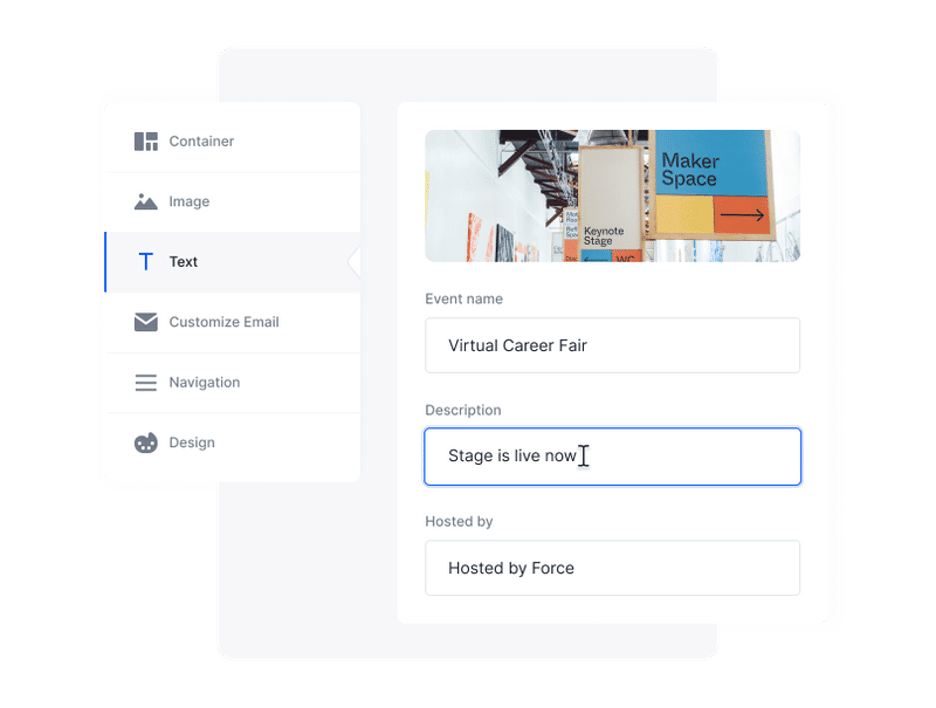
5. Create consistent event branding.
Branding is powerful.
Research shows that strong branding can decrease price sensitivity and increase customer satisfaction and loyalty.
The average open rate for even emails is only 20-30%, especially when attendees are strapped for time. And those who open the emails don’t even necessarily read through it. But branding can change that.
The images, colors, fonts, and visual tone that make up your event branding convey what kind of experience attendees will get.
Make sure to customize these aspects of your event branding:
- Logo
- Set and stage design
- Theme colors and fonts (which can be incorporated through RingCentral Events Canvas drag-and-drop website builder and through advanced branding options)
- Images (from web page and email headers to headshots to social media posts)
- Digital ads
- Goody bags and swag
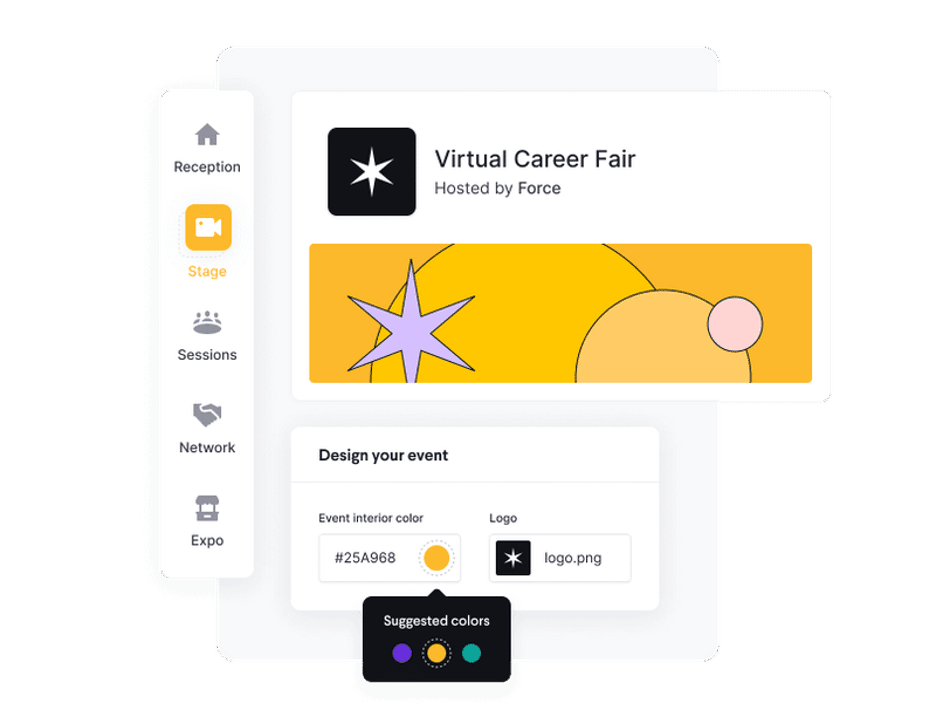
6. Choose the right event management technology.
Managing an event –– whether it’s hybrid, virtual, or in person –– requires the right tools.
The right event management platform should come with functionality that goes way beyond badge scanning and live streaming.
Because your event management software has a direct impact on your audience’s experience, investing in the right platform for your needs is crucial.
Here are some features to look for in your event management technology:
- Ticket buying and event registration options that are easy for attendees
- Virtual booth options for sponsors and partners
- Multiple spaces or stages for audiences and presenters
- Messaging capabilities, both for event staff and event attendees
- Polls and survey capabilities
- Branding options
- Integrations that offer interactive options, like whiteboards, games, and chats
- Integration with on-site tools like QR code scanning, cashless payments, badge and wristband printing, access control management, certification issuance, and contactless check-in
7. Gather and analyze event data to improve future events.
Moving through an event requires a lot of planning, tracking, and, sometimes, crisis management. Once your event is complete, you can look forward to one of the most interesting parts of event management: the post-event recap.
With the right event platform, there is a lot of valuable event data to analyze.
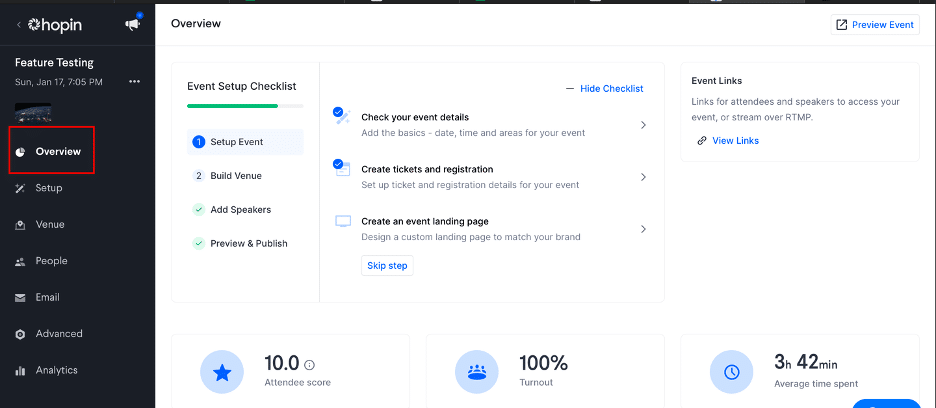
For instance, RingCentral Events’ dashboards include data on:
- Number of sessions and booths
- Registrations, sortable by country and ticket type
- Event turnout
- Attendee Net Promoter Score (NPS)
- Time spent in event
- Top areas by chat messages
- Top areas by attendees
- Top expo booths by interaction
RingCentral Events automatically creates summary reports after your event is over to capture all of that data so you can use it to inform future events.
Looking at this data allows businesses to focus on the type of event that’s most successful for their audience.
“We actually learned a lot about our audience and our community through virtual and digital events,” says Amelia Ibarra, senior vice president and general manager at SaaStr. “So we did about a dozen of them before our in-person event. And we saw that what we believed kind of in our gut was reflected in their data.”
After seeing what the data showed, Amelia and her team adjusted their plans.
“We added a lot of round tables,” she says “We added a lot of small group sessions because a lot of people came through our digital events who were really great like-minded people in our community who should be raised up to a speaker level.”
Event management is always evolving
The fundamentals of event management are constant. But as technology and trends shape our future, event managers need to apply their skills differently to solve the challenges ahead.
If you are looking for an experienced team who can help you stay ahead of the curve, RingCentral Events will work closely with you every step of the way so that together we create flawless events everyone talks about months after they happened.
Request a free demo or speak with one of our event experts today.
Originally published Sep 01, 2022, updated Nov 10, 2023
